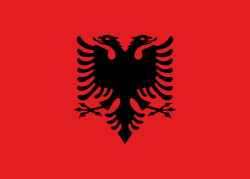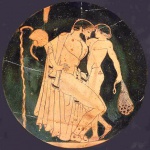Albanian pederasty: Difference between revisions
No edit summary |
Moved the page from the "Europe" category to the "Albania" category |
||
| (2 intermediate revisions by one other user not shown) | |||
| Line 9: | Line 9: | ||
==Aspects of the relationships== | ==Aspects of the relationships== | ||
Although homosexual relations were common among the predominantly Muslim population, such relationships have been reported even among Christians, for whom there was also a special ceremony performed by a priest in church to seal the union, called vellameria (Albanian vella, "brother" and marr, "to accept"). Jealousy was a frequent occurrence, and sometimes men committed murder because of a boy. <ref>Havelock Ellis, Studies in the Psychology of Sex, Sexual Inversion, Ch.I</ref> | Although homosexual relations were common among the predominantly Muslim population, such relationships have been reported even among Christians, for whom there was also a special ceremony performed by a priest in church to seal the union, called [[vellameria]] (Albanian vella, "brother" and marr, "to accept"). Jealousy was a frequent occurrence, and sometimes men committed murder because of a boy. <ref>Havelock Ellis, Studies in the Psychology of Sex, Sexual Inversion, Ch.I</ref> | ||
According Naecke: "Albanians in the north have a love of all boys and are excited to spend time with beautiful young men. Their passion and their jealousy is so strong that even today sometimes there are cases of suicide ... In addition, it is true that when are couples are blessed by the priests - the two partners who share the Eucharist immediately after "<ref>Edward Carpenter, Intermediate Types among the Primitive Folk p.127</ref>. | According Naecke: "Albanians in the north have a love of all boys and are excited to spend time with beautiful young men. Their passion and their jealousy is so strong that even today sometimes there are cases of suicide ... In addition, it is true that when are couples are blessed by the priests - the two partners who share the Eucharist immediately after "<ref>Edward Carpenter, Intermediate Types among the Primitive Folk p.127</ref>. | ||
| Line 101: | Line 101: | ||
{{Navbox Pederasty|collapsed}} | {{Navbox Pederasty|collapsed}} | ||
[[Category:History]] | [[Category:History]] | ||
[[Category:Albania]] | |||
Latest revision as of 23:27, 19 November 2019
Albanian pederasty was a practice reported by many Western travelers in the nineteenth century [1] [2] including Edvard Westermarck [3], John Cam Hobhouse, who in his diary [4], indicates that pederasty was " openly practiced, "and Johann Georg von Hahn [5], also known as" the father of Albanian studies. "[6] According to these reports pederasty was common and it was socially accepted that young people between sixteen and twenty-four years seduce boys of twelve to seventeen. [5]
In literature, the older lover is called Ashik (from the Arabic ishq, "passionate love") and the beloved, dyllber (from turkish Dilber, "beautiful") [7]. A Gheg married at the age of 24 or 25 years, and then usually but not always, gave up the love with the boys. Ghegs are one of two major ethnic subgroups of Albanians, the other being the Tosks.[8]
The practice was limited with the advent of communism in 1944. [9]

Aspects of the relationships
Although homosexual relations were common among the predominantly Muslim population, such relationships have been reported even among Christians, for whom there was also a special ceremony performed by a priest in church to seal the union, called vellameria (Albanian vella, "brother" and marr, "to accept"). Jealousy was a frequent occurrence, and sometimes men committed murder because of a boy. [10]
According Naecke: "Albanians in the north have a love of all boys and are excited to spend time with beautiful young men. Their passion and their jealousy is so strong that even today sometimes there are cases of suicide ... In addition, it is true that when are couples are blessed by the priests - the two partners who share the Eucharist immediately after "[11].
Travelers who visited the country, including the French historian François Guillaume Frederick (Baron de Vaudoncourt) and George Gordon (Lord Byron). There is also mention of Ali Pasha being interested in this kind of love, describing his harem of beautiful young boys, which drew not only lovers, but even his most trusted associates, like the greek Athanase Vaya, who became his right arm as well as a general [12].
Poetic and literary references
Some Western observers reported the practice in a negative light. François Pouqueville, the consul general of Napoleon in Albania between 1805 and 1815, dtated than the Albanians accused of being "no less profligate in this regard that the other inhabitants of modern Greece, without any apparent idea of the enormity of the crime." [13]
Others presented it as surprisingly positive, especially in light of the cultural values of the educated European audience of the period, for which the publication was intended. The following passage is reported by Hahn as the actual language used to him by a Gheg Albanian:
The lover's feeling for the boy is pure as sunshine. It places the beloved on the same pedestal as a saint. It is the highest and most exalted passion of which the human breast is capable. The sight of a beautiful youth awakens astonishment in the lover, and opens the door of his heart to the delight which the contemplation of this loveliness affords. Love takes possession of him so completely that all his thought and feeling goes out in it. If he finds himself in the presence of the beloved, he rests absorbed in gazing on him. Absent, he thinks of nought but him. If the beloved unexpectedly appears, he falls into confusion, changes color, turns alternately pale and red. His heart beats faster and impedes his breathing. He has ears and eyes only for the beloved. He shuns touching him with the hand, kisses him only on the forehead, sings his praise in verse, a woman's never.
Hahn documented a number of Gheg, the Albanian language spoken in Northern Albania, Kosovo, Macedonia, Montenegro and southern Serbia, pederastic poems, written by one poet, such as the following:
S'gjen ndonji zok qi kendon,
Te gjithe jane e po qajne.
I mjeri ashik sa fort po duron,
Prej dyllberit po e dajne.
Dilli, qi len ne mengjes
Si ti, o djal, kur me zallandise
Kur me kthen syt' e zes'
Shpirt ment prej kres' mi gremise.
You'll find no bird that sings,
They all just sit and cry.
The poor lover, how strongly he endures,
[For] they separate him from his beloved. The sun, when it rises in the morning,
Is like you, boy, when you are near me.
When your dark eye turns upon me,
It drives my reason from my head.
— Neçín of Përmet, son of Ali Pasha Frakulli, mid 19th century; translation by Nicholas Zymaris
The intensity of the feelings is reflected in native pederastic poetry such as the following verse.
Të kálli Hasán káfpeja
Të mos bánish Bajrám,
Se kështú qen’ka bes’e feja. Núri yt, o Suleimán!
Bukurínë t’a dha Zot yn,
Mos ubán makrúr.
Tyj, o cun, të púthça syt’,
E t’udjéksha nur. Hasan,
you slanderous whore
Who won’t celebrate Bairam,
For thus they were from honor and faith. Your radiance, O Suleiman!
Your beauty was given you by our Lord,
Be not so proud.
O that I may kiss your eyes, boy,
And burn up in your radiance.
— Neçín of Përmet; tr. Nicholas Zymaris
Pashalik of Ioannina
According to historians the harem of the Muslim Albanian leader of Ioannina, Ali Pasha (during Ottoman rule), consisted of some hundreds of young girls and good looking boys [14]. A local south Albanian folk song records:
Mos jemi çupa nga Narta edhe djemi nga Gjirokastra të loç ti me 'ta nga nata |
We're not the girls from Arta and the boys from Gjirokastër Like those you play with at night |
See also
Sources
- Erich Bethe, Die dorische Knabenliebe: ihre Ethic und ihre Idee 1907
- Robert Elsie, A Dictionary of Albanian Religion, Mythology, and Folk Culture
- J.G. von Hahn, Albanische Studien, 1854, p. 166
- Paul Näcke, Jahrbuch für sexuelle Zwischenstufen, vol. ix, 1908, p. 327
- Edward Westermarck, "Homosexualität." Translated by L. Katscher
Notes
- ↑ Bethe, Rheinisches Museum für Philologie, 1907, p. 475
- ↑ Näcke, Jahrbuch für sexuelle Zwischenstufen, vol. ix, 1908, p. 327
- ↑ Robert Deam Tobin, Warm Brothers: Queer Theory and the Age of Goethe (New Cultural Studies Series) p.58
- ↑ The Diary of John Cam Hobhouse (October 20th, 1809)
- ↑ Jump up to: 5.0 5.1 J.G. von Hahn, Albanische Studien, 1854, p.166
- ↑ Robert Elsie, A Dictionary of Albanian Religion, Mythology, and Folk Culture p.202-3
- ↑ http://www.eskimo.com/~nickz/orth_gay.txt
- ↑ Piotr Eberhardt (January 2003). Ethnic Groups and Population Changes in Twentieth-century Central-Eastern Europe: History, Data, and Analysis. M.E. Sharpe. p. 433. ISBN 978-0-7656-1833-7. http://books.google.com/books?id=jLfX1q3kJzgC&pg=PA433. Retrieved on 13 July 2013. "The Albanians comprise two ethnic subgroups: the Ghegs, who generally occupy the area north of the Shkumbin river; and the Tosks, most of whom live south of the river."
- ↑ Michael Worton, Nana Wilson-Tagoe National Healths: Gender, Sexuality and Health in a Cross-Cultural Context p.48-50
- ↑ Havelock Ellis, Studies in the Psychology of Sex, Sexual Inversion, Ch.I
- ↑ Edward Carpenter, Intermediate Types among the Primitive Folk p.127
- ↑ Stephen O. Murray and Will Roscoe, Islamic Homosexualities, p.189-191
- ↑ Murray, op.cit.
- ↑ Pyrrhus Ruches. Albanian historical folksongs, 1716-1943: a survey of oral epic poetry from southern Albania, with original texts. Argonaut, 1967 p. 19
